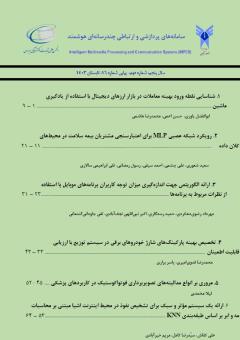مروری بر انواع مدالیته های تصویربرداری فوتواکوستیک در کاربردهای پزشکی
محورهای موضوعی : پردازش چند رسانه ای، سیستمهای ارتباطی، سیستمهای هوشمند
1 - استادیار، گروه مهندسی برق، دانشکده برق و کامپیوتر، واحد زنجان، دانشگاه آزاد اسلامی، زنجان، ایران
کلید واژه: میکروسکوپی فوتواکوستیک, توموگرافی کامپیوتری فوتواکوستیک, آندوسکوپی فوتواکوستیک, رزولوشن, کنتراست,
چکیده مقاله :
مدالیته های تصویربرداری پزشکی نقش مهمی را در تشخیص، مرحله بندی، درمان و پایش روند درمان بیماری ها ایفا می کنند. یکی از روش هایی که در سال های اخیر وارد عرصۀ تحقیقات پزشکی شده است، تصویربرداری فوتواکوستیک است که به علّت خواصی چون غیرتهاجمی بودن، امنیت بیشتر به دلیل استفاده از تشعشعات غیریونیزان و سهولت کاربرد، در بسیاری از حوزههای پزشکی مورد توجه قرار گرفته است. این تکنیک تصویربرداری ترکیبی از دو تکنولوژی فراصوت و نوری بوده و در نتیجه مهم ترین مزیت و علّت توجه به آن بهره بردن از کنتراست بالای تصویربرداری نوری و رزولوشن بالای تصویربرداری فراصوت می باشد. در این مقاله به بررسی اصول اساسی تصویربرداری فوتواکوستیک و انواع مدالیته های رایج آن در کاربردهای پزشکی شامل میکروسکوپی فوتواکوستیک، توموگرافی کامپیوتری فوتواکوستیک و آندوسکوپی فوتواکوستیک و همچنین چالش های موجود در این حوزه پرداخته ایم. مطالعات انجام شده قابلیت به کارگیری تکنیک فوتواکوستیک را در فراهم آوردن اطلاعات مولکولی، ساختاری و عملکردی از بافت های بیولوژیکی نشان می دهد.
Abstract: Medical imaging modalities play a crucial role in the diagnosis, staging, treatment, and monitoring the treatment process of diseases. Photoacoustic imaging has emerged as a recent addition to medical research, offering non-invasiveness, enhanced safety due to non-ionizing radiation, and ease of application in various medical fields. This imaging technique combines ultrasound and optical technologies, providing the significant advantage of high-contrast optical imaging and high-resolution acoustic imaging. This article reviews the fundamental principles of photoacoustic imaging and its common modalities used in medical applications, including photoacoustic microscopy, photoacoustic computed tomography, and photoacoustic endoscopy, as well as the challenges in this field. Studies indicate the potential of photoacoustic technique in providing molecular, structural, and functional information from biological tissues.
Introduction: Combined imaging methods utilizing the capabilities of integrated systems enhance the quality of obtained images compared to single-modality systems. One such combined method is the photoacoustic tomography, which is based on the photoacoustic effect or the detection of ultrasound waves generated by laser irradiation. Common modalities of photoacoustic tomography include photoacoustic microscopy, photoacoustic computed tomography, and photoacoustic endoscopy, each serving specific imaging depths and resolutions. This study explores the types of photoacoustic imaging modalities and evaluates their capabilities.
Method: This article aims to present fundamental principles of photoacoustic imaging and common modalities through a review of relevant studies. Additionally, it investigates the contrast agents contributing to the imaging capabilities of photoacoustic technique in providing molecular, structural, and functional information of biological tissues.
Results: Photoacoustic imaging, utilizing both ultrasound and optical technologies, produces high-contrast images with desirable spatial resolution. It proves valuable in the fields of diagnosis, staging, and monitoring of various diseases. Microscopic photoacoustic and endoscopic photoacoustic modalities are commonly employed for imaging at millimeter depths with micrometer resolution, while photoacoustic computed tomography is versatile for both microscopic and macroscopic imaging purposes.
Discussion: Photoacoustic imaging plays a crucial role in diagnostic studies from organells to organs, offering high-contrast and high-resolution images while remaining non-invasive and non-ionizing. This method facilitates the examination of essential physiological and determining parameters in specific pathologies, providing insights into molecular, structural, and functional aspects of biological tissues.

